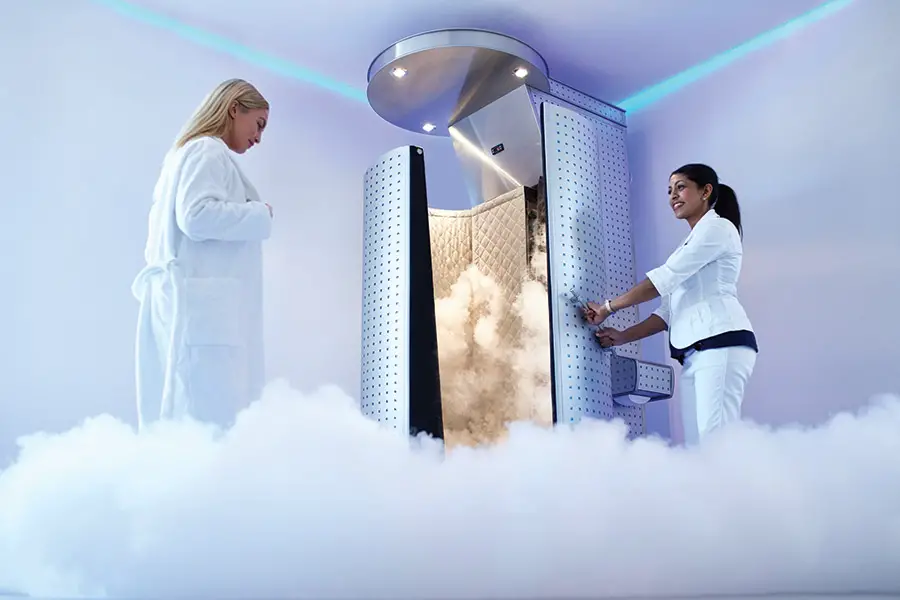Saunas and cryotherapy are on the opposite ends of the heat spectrum, with both providing excellent health benefits to users. It’s easy to understand that cryotherapy makes your body cold, while saunas make your body hot. So, you might wonder what effects very cold and hot temperatures can have on your body in a certain timespan. Can you do cryotherapy and use a sauna on the same day?
Cryotherapy and saunas can be used on the same day, and using them the same day may provide additional health benefits. If you choose to do both within 24 hours, you should space them out by 5 to 6 hours if you’re new to either treatment, but you can work up to doing them back to back.
Using cryotherapy and saunas together on the same day could provide a calming and relaxing experience and make you more limber. It reduces joint discomfort and may cause skin issues to clear up after just a few sessions. The hot and cold treatments together can also promote better sleep quality. However, there are some recommendations out there to space out your treatments to allow your body to get the most benefits. Let’s look at how these treatments work to understand if we should do them back to back.
How Does Cryotherapy Work?

To undergo cryotherapy, you enter an enclosed chamber that has a hole for your head. The chamber is then pumped with supercooled nitrogen or argon gases that reduce the temperature down to -220°F. Don’t worry; you’ll stay inside for no more than a couple of minutes. Although cryotherapy is not yet an FDA-approved treatment for any medical condition, many users have claimed to have experienced various health, body, and mind improvements.
Just like there are various forms of heat therapy that fall under the broad category of “saunas” (like steam rooms, dry saunas, traditional saunas, and sauna blankets), there are also several methods of performing cryotherapy. Entering a chamber that is then filled with nitrogen, submerging in an ice bath, or simply standing outside when it’s very cold are all ways to achieve cold-exposure in a way that is therapeutic.
How Cryotherapy Effects the Body
When your body is exposed to the freezing cold temperatures of cryotherapy, it increases its blood flow to your vital internal organs to prioritize keeping them warm. Once you’re out of the cryotherapy chamber and your body reacclimates to the normal temperature, your blood will begin rushing back to your extremities and skin. The blood will carry oxygenated hemoglobin to your skin and joints, which reduces inflammation, boosts neuromuscular transmission, improves circulation, and increases immune response.
According to some scientific studies, the boosted immune response by cryotherapy is marked by the development of more anti-inflammatory cytokines, reduced pro-inflammatory prostaglandin PGE2, and production of more white blood cells – (your infection-fighting blood cells). As you can see, shocking your body with a quick spike of cold temperature results in many automated responses of your body that could improve your health and well-being.
Why do People Use Cryotherapy?
Many athletes, models, and actors use cryotherapy for not only the potential health benefits but for its performance-enhancing benefits as well. The exposure to cryotherapy’s cold temperatures quick-starts a response in your body that can lead to:
- Endorphin production — Boosts your mood and overall well-being.
- Faster workout recovery — Might be a result of the increased oxygenated hemoglobin in your blood.
- Improved muscle strength — Again, possibly a result of increased oxygenated blood.
- Improved joint function — Cryotherapy reduces inflammation in your joints, improving function.
- Better collagen growth — Collagen improves your skin’s elasticity and health.
Many professional athletes swear by cryotherapy and even claim performance improvements based on recurring cryotreatment sessions. However, it’s unclear and difficult to verify if cryotherapy helps with sports performance or if it is more of a placebo effect.
How Does a Sauna Work?
There are many different types of saunas available, and you can read more about the different types of saunas in our separate guide, but the two most common types are traditional hot air saunas and infrared saunas. Traditional saunas have wooden interiors that are heated by either electric heaters or wood-burning furnaces. They heat sauna rocks, producing dry heat with low humidity. The temperature of traditional saunas is typically 160-230°F (70-110°C), with humidity ranging from 5-30%.
The humidity can be adjusted by splashing water onto the hot sauna rocks, and users employ sauna hygrometers (on Amazon) to ensure they have the proper temperature and humidity. On the other hand, infrared saunas use infrared (IR) or far-infrared (FIR) radiation to heat your body. Don’t worry; infrared and far-infrared waves are entirely harmless.
In fact, this is basically the same way your body heats up from direct sunlight. Infrared saunas don’t heat up the entire room directly, so you’ll find no sauna rocks in the room. The humidity level in IR saunas can’t be adjusted either but are typically designed with a more modern look (or more similar to a traditional wooden sauna). You’ll also notice IR panels in infrared saunas, typically on the walls and sometimes the ceilings too.
The Potential Health Benefits of Saunas
If you look into the history of saunas, it turns out they’ve been used for thousands of years, and our understanding of their health benefits has grown over that time. The potential health benefits saunas provide are related to circulation, cardiovascular, and a reduction of stress. The heat of the sauna causes your body to increase circulation as it tries to keep itself cool.
It’s common for heart rates to rise above 100 beats per minute in hot saunas, which has cardiovascular benefits in its own right. Increased circulation helps to ease pain related to muscle soreness and inflammation of joints and arthritis. Saunas reduce stress levels; the high temperatures promote relaxation and improve well-being. This is obviously great for a person’s cortisol levels, the chemical that is known for producing an inflammatory response that causes a whole host of other health problems.
How Saunas Affect the Body
Saunas affect the body by warming it with a high temperature. A traditional sauna can raise skin temperature above 100°F (40°C) and raise the core body temperature. The intense heat exposure activates your body’s temperature regulation systems – which, in short, increases your heart and blood circulation, providing more blood to the skin while at the same time increasing sweating. The body has many responses to maintain homeostasis.
All of these responses are efforts of your body to dissipate the extra heat to maintain that homeostasis, a term that purports to describe a level of stability among interconnected elements in the body, including temperature, liver function, etc. Along with these responses comes cellular changes such as the production of heat-shock proteins, reduction in oxidative stress, increased nitric oxide bioavailability, and reduced inflammation. Some scientific studies have shown these effects.
Doing Cryotherapy and Sauna on the Same Day
Completing a cryotherapy session and a sauna visit on the same day is certainly possible. Some people have done it without ill effects. However, there is no data to suggest that it is especially good for your body. In fact, the majority of cryotherapy salons recommend waiting at least 5-6 hours before visiting a sauna for reasons we’ll explore again in a moment. Ideally, it is best to give your body time to return to its normal state before going from cryotherapy to a sauna and vice-versa.
And if you have any medical issues (i.e., heart issues, COPD, pregnancy, hypertension, kidney disease, etc.) that would prevent you from using saunas or cryotherapy by themselves, obviously you should avoid using them entirely and not be considering doing them back to back or in the same day. Always talk to your medical provider if you are in doubt about your health conditions and how the sauna or other therapies would affect them.
Is it Healthy to do Cryotherapy and Sauna on the Same Day?
Saunas and cryotherapy sessions both have their own health benefits if done individually. Additionally, it is recommended to start cryotherapy and saunas both beginning from a normal, baseline temperature. That’s why most cryotherapy and sauna businesses recommend waiting multiple hours in between. All data and statistics around the health benefits of cryotherapy and sauna use were based on the participants using them individually and not jumping from one to the other. As such, no data shows additional health benefits if done on the same day.
Does it Matter if you do Cryotherapy or Sauna First?
If you do decide to use cryotherapy and a sauna on the same day, it doesn’t matter which one you do first— however, most people like doing the sauna first and cryotherapy last. The reason is that it feels nice to go from a hot temperature into a cold temperature. However, others prefer doing the cold temperature first, letting their body warm back to its baseline, then using the sauna to warm up their core. Whichever order you choose, be sure to space them out appropriately.



